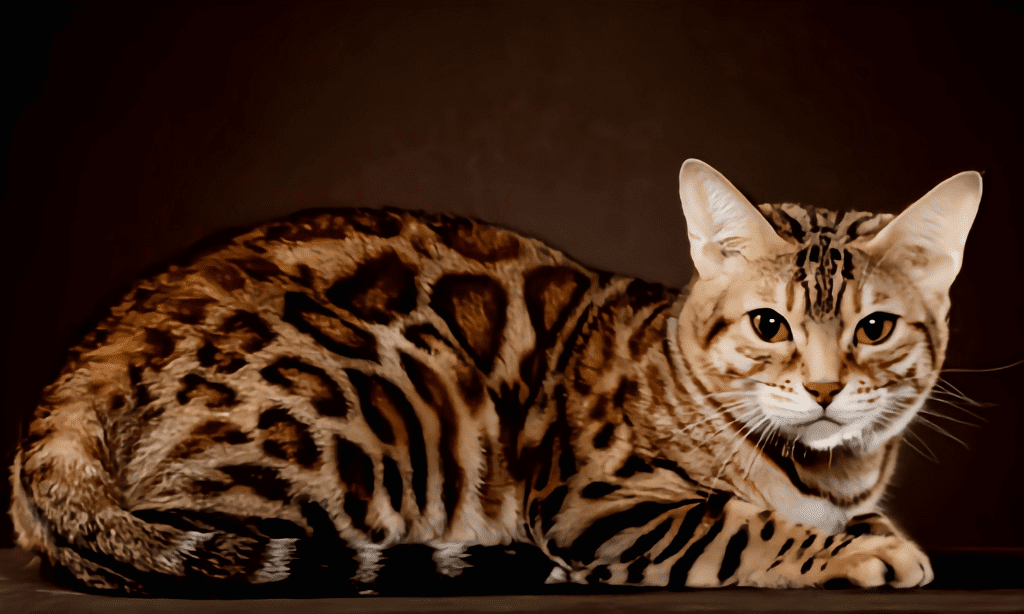
What if you could own a pet that looks like a leopard, acts like a dog, and has the curiosity of a monkey? Enter the Bengal cat—a breed so extraordinary that it blurs the line between domestic companion and wild predator. With glittering coats, muscular 15-pound physiques, and problem-solving skills rivaling primates, Bengals are not just pets—they’re a lifestyle. Let’s unravel every secret of this mesmerizing breed, from its rainforest roots to its modern-day reign in living rooms.
1. Anatomy of a Bengal Cat: A Masterpiece of Nature
Names & Origins
- Official Name: Bengal Cat (derived from the Asian leopard cat’s scientific name: Prionailurus bengalensis).
- Aliases: “Living Artwork,” “Miniature Leopard,” “Velcro Cat” (for their clingy nature).
- Wild Ancestry: Originating from crossbreeding domestic cats with the Asian leopard cat in the 1960s, Bengals retain 4–10% wild DNA, visible in their athletic build and primal instincts.
Physical Specifications
- Weight:
- Males: 12–15 pounds (up to 20% heavier than most domestic breeds).
- Females: 8–12 pounds (but pound-for-pound stronger than typical house cats).
- Height: 13–16 inches at the shoulder—comparable to a small spaniel.
- Lifespan: 12–16 years (with records of Bengals living to 18+ years on high-protein diets).
Signature Features
- Coat:
- Patterns: Rosettes (donut-shaped spots), marbling (swirling stripes), or spotted tabby.
- Colors: Brown spotted (most common), silver, snow (lynx point, sepia, mink), and rare “charcoal” Bengals with facial masks.
- Glitter Gene: A unique trait causing their fur to shimmer like “gold dust” under sunlight.
- Tail: Thick and muscular, resembling a raccoon’s with alternating dark/light bands.
- Ears: Small, rounded, and forward-tilted—designed to mimic wild cats’ alert posture.
- Eyes: Large, almond-shaped, in hypnotic hues: gold, green, blue (in snow Bengals), or “aqua” (a turquoise shade exclusive to the breed).
2. Personality Deep Dive: The Einstein of Cats
Bengals are the border collies of the feline world—endlessly curious, trainable, and demanding engagement. Forget aloof lap cats; Bengals will:
- Open doors (yes, even round handles).
- Play fetch with crumpled paper for hours.
- Learn commands like “sit” or “high five” for treats.
- Swim voluntarily (most cats hate water, but Bengals often splash in bathtubs!).
Temperament Breakdown:
- Energy Level: Extreme—requires 2+ hours of interactive play daily.
- Intelligence: Capable of solving puzzle feeders in seconds. A 2020 UC Davis study ranked Bengals as the 2nd most intelligent cat breed after Abyssinians.
- Social Needs: Thrives in families, but can become destructive if left alone >6 hours.
- Vocalizations: Communicates through chirps, trills, and loud meows—some owners joke they’re “part parrot.”
Pro Tip: “Bengals need vertical territory,” says Jackson Galaxy, cat behaviorist. Install 6+ ft cat trees and wall shelves to prevent counter-surfing.
3. The Bengal’s Jungle Roots: A 60-Year Breeding Saga
The Bengal’s creation is a tale of science meets obsession:
- 1963: Geneticist Jean Mill crosses a female Asian leopard cat with a black tomcat, producing “KinKin”—the first hybrid.
- 1980s: Breeders introduce Egyptian Maus and Abyssinians to refine the Bengal’s temperament.
- 1991: The International Cat Association (TICA) grants championship status.
Controversy: Early hybrids (F1–F4 generations) were illegal in some states due to “wild animal” laws. Modern Bengals (F5+) are 100% legal and domestic.
4. Bengal Cat Care: Step-by-Step Mastery
Diet: Fuel for a Feline Athlete
- Protein: Aim for 40–50% protein content (chicken, rabbit, or duck). Avoid plant-based fillers.
- Hydration: Bengals are prone to kidney issues. Use water fountains to encourage drinking.
- Toxic Foods: Chocolate, grapes, and onions—Bengals’ curiosity can lead to counter theft!
Health Red Flags
- Hypertrophic Cardiomyopathy (HCM):
- Affects 1 in 7 Bengals.
- Symptoms: Lethargy, rapid breathing.
- Prevention: Annual echocardiograms.
- Progressive Retinal Atrophy (PRA):
- Genetic test available for breeders.
- Flat-Chested Kitten Syndrome:
- 10% of Bengal litters; most outgrow it by 12 weeks.
Grooming Hacks
- Brushing: Weekly with a silicone grooming mitt to enhance glitter effect.
- Nail Trimming: Every 2 weeks—their claws grow 50% faster than average cats.
- Teeth: Brush 3x weekly to prevent periodontal disease (common in Bengals over age 5).
5. Who Should (and Shouldn’t) Own a Bengal?
Perfect Match:
- Adventure Seekers: Owners who enjoy teaching tricks or hiking with cats.
- Multi-Pet Homes: Bengals bond well with dogs (especially retrievers) and outgoing cats.
- Space-Rich Environments: Apartments need catios or leash training for mental stimulation.
Avoid If:
- You prefer a “decorative” pet—Bengals demand interaction.
- You’re on a budget: Vet bills, premium food, and enrichment toys cost $1,200+/year.
6. FAQ: Burning Questions Answered
- “Do Bengal cats shed?”
Yes, but minimally—their short fur sheds 80% less than Persians. - “Are Bengals aggressive?”
No! Well-socialized Bengals are gentle but may play-bite during overstimulation. - “Why does my Bengal cat lick water?”
A wild instinct—Asian leopard cats lick dew from leaves. Provide a moving water source to satisfy this quirk.
7. Celebrity Bengals & Pop Culture Clout
- Taylor Swift’s Bengal, Olivia Benson: Often seen in Instagram posts opening gift boxes.
- Pete Davidson’s “Mango”: A silver Bengal trained to ride skateboards.
- Netflix’s ‘Tiger King’ Effect: Bengal adoptions surged 300% post-2020—rescue groups now warn against impulsive “lockdown purchases.”
Final Verdict: Is the Bengal Cat Your Spirit Animal?
Bengals are not for the faint-hearted. They’ll steal your sushi, dominate Zoom calls, and redefine “cat person.” But for those craving a pet with the soul of a panther and the charm of a golden retriever, the Bengal is unmatched.🐆✨